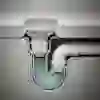Frequently Asked Questions (FAQs) on P-Trap Maintenance
1. What is a P-Trap, and why is it so important?
The P-trap is the U-shaped or curved section of pipe located directly under every sink, shower, tub, and floor drain.
Purpose: Its essential function is to hold a small amount of water, which creates a water seal that prevents sewer gases (which can contain harmful gases like hydrogen sulfide and methane) from backing up through the drain and into your home.
2. Why does my P-trap smell like sewage or rotten eggs?
The most common reason is a Dry P-trap. If a fixture isn't used for an extended period (usually 3–5 months), the water in the trap evaporates, breaking the water seal and allowing sewer gas to flow directly into the room.
Secondary Cause: Significant organic build-up (biofilm, hair, soap scum) inside the trap is decaying, producing foul, gassy odours.
3. How do I fix a dry P-trap?
The fix is usually simple: Pour water down the drain. For a sink or shower, run the water for 1 to 2 minutes, or pour about a half-gallon down the drain to restore the water seal.
Maintenance Tip: For infrequently used drains (such as guest bathrooms or basement floor drains), pour a cup of water down each drain at least once a month to prevent evaporation.
4. How can I keep the water from evaporating so quickly?
After refilling the trap with water, pour about 1 tablespoon of mineral oil (or unscented baby oil) down the drain. The oil is lighter than water and floats on top, creating a barrier that slows down water evaporation.
5. What should I use to clean a smelly P-trap?
Natural solutions are often the safest and most effective for odor-causing biofilm:
Pour 1 cup of baking soda down the drain.
Follow with 1 cup of white vinegar.
Let it fizz and sit for 10–30 minutes to break down the grime and neutralize odors.
Flush with hot tap water.
Caution: Avoid mixing different chemical drain cleaners, as this can create dangerous gases.
6. Do I ever need to manually clean the P-trap?
Yes, manual cleaning is necessary if the drain is slow or consistently smelly due to a severe hair or grease clog.
Place a bucket under the trap.
Carefully use a wrench or pliers to loosen the slip nuts holding the trap in place.
Remove the U-shaped pipe and manually clear the accumulated debris.
7. What if the P-trap is full, but the smell persists?
If the water seal is clearly present and the drain is clean, the issue is likely related to the larger plumbing system:
Vent Pipe Blockage: A clogged plumbing vent (usually on the roof) can cause negative pressure, allowing sewer gas to be forced into the home.
Leaky/Damaged Pipe: There could be a leak or crack in a drainpipe farther down the line, or a failed seal (such as a toilet wax ring).
Action: At this point, you should call a licensed plumber to professionally diagnose the venting or pipe damage.

